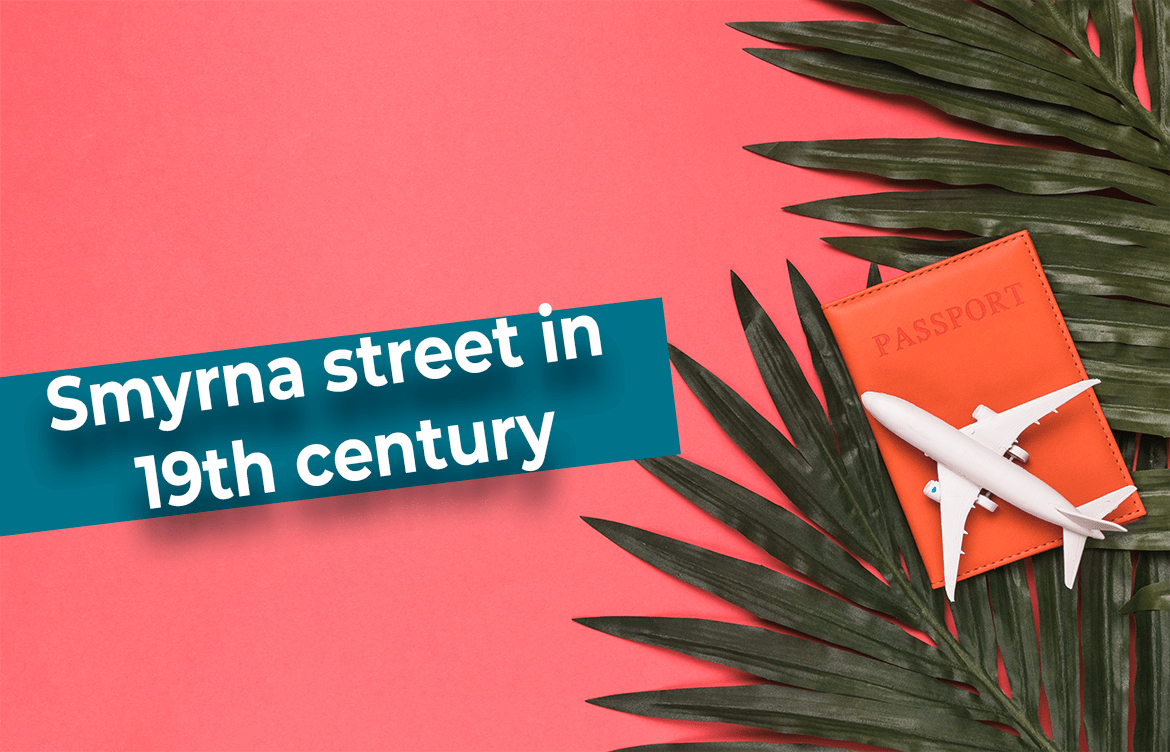Smyrna Street İn 19th Century
The 1840 guide is brutal about the streets of the city: “Like all the other big cities in Turkey, this city looks beautiful from afar but doesn’t satisfy expectations when viewed up close.
The city is overpopulated, and the streets are narrow and dirty. In 1878, only the streets in the Jewish quarter were called narrow and filthy while the streets in the Turkish neighborhood were called picturesque and interesting.
The streets in the Armenian Quarter, which were renovated after the fire in 1845, were mentioned as organized and clean. According to the guides, the Izmir Market is one of the most popular attraction points: “You can find many French and British luxury products in the market in Izmir.” (1840/261). However, it is said that you need a tour guide to shop and discover the market. (1895/77).
Entertainment
Information regarding entertainment was limited to activities on the Kordon. During the summer, there were French plays and Italian operas in the garden of Alhambra and Greek comedies at Theatre de Quins. Some of the cafes offer good music. During the winter, there are concerts in bars and plays in one of the cafes. Once a year, the next Thursday after the Greek festival, horse races are organized in Buca. There are whirling dervishes in the Turkish quarter and dervishes in the Armenian quarter. (1895/76)
Antique remains
Information about the important buildings in the city and antique remains in Murray’s first guide are limited and repetitive. The fortress on the peak of Pagos Mountain, the old theater, and the stadium was mentioned only briefly. (1840/263) However, there is more information about the antique remains in the city in the 1894 guide. Information about the antique topography begins with the acropolis and the walls that surround the acropolis: “The Lysimachus Acropolis is situated in the western part of Pagos Mountain and you can still see the Greek stone workmanship in the lower parts of the walls.
From this point, the walls of the city stretch to the west and north. The wall first rises towards the hill above the stadium, circles the Turkish cemeteries, passes by the old Jewish cemetery, and reaches the sea near Karataş. A few years ago, the pieces which were 1, 80 meters thick were visible. On the other side, the walls begin from the northwestern part of the acropolis and stretch towards Basmahane Station in a straight line, veer right, encircle the Armenian Church, and end at S. Peter Castle.
The remains of the wall can be seen near the theater, the station, and in the courtyard of a house in the Armenian quarter. The guard towers have disappeared, but some epigraphs contain their names. The places of two of the gateways are known; one of them is in the southwestern part of the Turkish quarter and is known as the Efes Gateway.
The other one is called the Black gateway by the Turks. The epigraph here suggests that Heraclius renovated the walls. The avenue that connected these two doors was known as the Golden Avenue. İzmir had many temples in Izmir including Homerism, which was dedicated to Homer, Nemesis, Kibele, “Metroum”, Aesculapius, Jupiter Acreus, Apollon, Anubis, Serapes, Artemis, and Venus. Also, there was a prytaneum, a theater, a stadium, an odeon, a public library, and a two-story portico.
Only a few remains of these buildings still stand. The theater, located on the outskirt of Pagos Mountain, was one of the largest theaters in Ionia and could accommodate 20, 000 people.
The only thing that remains from the theater is an arched passageway that attracts attention with its stones. The proscenium and the orchestra were built above the stage, and nothing remains from the cave.
The Grand Vezir Inn was built from the remains of the theater. The stadium is located a little above the theater and stretches towards the northwest. Its lower structures were demolished a few years ago to make an additional room for a Turkish house. The Turkish tomb on its northwestern corner surrounded by cypress trees is a monumental tomb of St.
Paint of Izmir
One of the foremost vital changes in Ottoman art within the eighteenth and nineteenth centuries is murals that are supplementary to subject decorations. Murals, that began in the metropolis and quickly unfold to most of the structures in Anatolia and different regions at intervals the borders of the Turkish Empire, square measure the indication of a replacement type of decoration. Izmir’s doctrine structure was an especially important thing about the shaping of the city’s cultural and artistic life.
Distinctive murals and paintings were created within the cosmopolitan population of the city including Muslims, Armenians, Greeks, Jews, Levantines, and different Europeans. Usually painted in ceilings
The murals painted on the structures of the city don’t seem to be therefore alike in terms of faith or quality.
Paintings, that were applied to mosques, synagogues, inns, and hotels initiate to the tip of the nineteenth century or starting of the twentieth century and most of them square measure in homes. Most of the examples that have survived to the current date were employed in interior decoration. The examples we all know these days were applied on ceilings and a few were applied on niches on walls next to the way. Dreamy panoramas of unknown locations square measure the foremost painted things on murals on the structures in the city.
One of the panoramas within the Kapani Mansion in Namazgah and therefore the panoramas that fit the rounded passageway of Şadırvanaltı house of God square measure completely different from others since they depict the city and its section.




